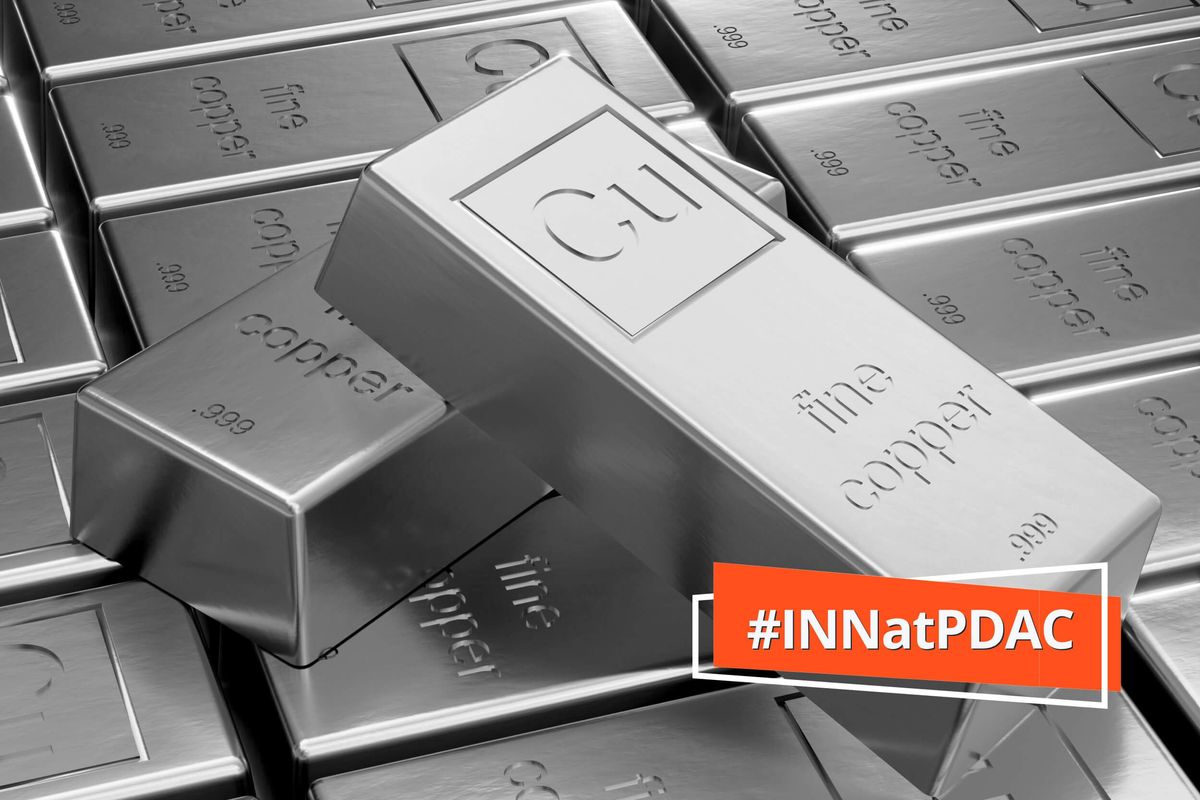Copper Crunch Coming as Demand Rises and Mine Supply Falls Short
Copper demand is rising as the energy transition gains steam, but years of underinvestment in exploration have left mine supply in the dust. Experts say big changes will be needed in the years ahead.

Since the advent of electricity, copper has played an essential role in energy generation and transmission. It will be similarly unreplaceable as the world moves away from fossil fuels to more sustainable sources of energy.
Pierre Lassonde, founder and chair emeritus of Franco-Nevada (TSX:FNV,NYSE:FNV), emphasized this during the "Where Will the Money Come From?" panel at the Prospectors & Developers Association of Canada (PDAC) convention.
“Copper is required for everything, and today 80 percent of terminal energy is carbon based and only 20 percent is electricity," he said. "If we want a green world, that has to be flipped around, where 80 percent of terminal energy has to be electricity. And the metal that carries electricity is copper in every which way. That is the key metal."
Energy transition fueling copper demand
The global population has become increasingly urbanized since the start of the Industrial Revolution. This shift from rural life accelerated through the 20th century, and urban populations officially overtook rural populations in 2007.
This is a trend that is set to continue — the United Nations projects that by 2050, 68 percent of the world's population of about 9.8 billion will live in cities. But with many cities lacking the infrastructure to support current populations, let alone growth, there will be even more demand for housing and basic infrastructure projects.
This shift toward urban centers is also happening at a time when the world is rapidly moving away from fossil fuels toward the clean promise of renewables. John MacKenzie, CEO of Capstone Copper (TSX:CS,OTC Pink:CSCCF) acknowledged this idea during PDAC's “Where Will the Money Come From?” discussion.
“The world is in a sort of transition at the moment because of decarbonization,” he told the audience at the convention. “It is an absolute must if we’re going to reduce the damage to the planet, and that’s going to require enormous amounts of critical metals, including copper, over the next 20, 30, 40 years.”
Dr. Michael Stanley, mining lead for the World Bank, went into greater detail during his “Catalyzing Minerals for Development” keynote presentation. “The key to growth and economic opportunity starts with energy," he said. "Energy is the kingpin to ensure that we move forward as a society. It allows us to improve our places of work, our housing, our hospitals — it allows for better delivery of education. It all starts with energy.”
He went on to explain that the greatest level of metals demand initially came when urban centers were still relatively young, but for much of the past 100 years demand has been based on incremental population growth with limited challenges to supply. The energy transition is set to completely disrupt this established pattern.
“This is very important, because the world is now challenged to replace electric systems and energy systems that the last 150 years have underpinned all economic development,” Stanley noted.
Adding another layer to this demand is the mainstream adoption of electric vehicles, which not only require more copper than internal combustion vehicles, but also place greater stress on the electrical grid.
Copper supply a decades-long problem
In the face of rising demand, copper is expected to face supply challenges as the market heads into deficit.
Speaking during a presentation titled “Is Global Exploration Meeting Commodity Needs?” Kevin Murphy, director of metals and mining research at S&P Global Commodity Insights, said the exploration side has been lagging for some time.
“So basically when I started with the company, we were saying, ‘This looks like a concern,’” he said. “Seventeen years later, (we’re saying) ‘Hey, this is still an escalating concern, why is this happening?’”
Like Murphy said, challenges around supply aren’t new. However, the narrative has changed. Stanley referred to a Businessweek article from December 1984 that discussed the economic viability of mining in the US.
At that time, there was concern that cheap labor from developing nations was undermining domestic production across the mineral resource sector. To a degree, the mining landscape today is mirroring what happened in 1984, with low-cost jurisdictions appealing to metals consumers, and some of the richest mineral deposits nearing depletion.
Over the years, new technologies and processes have made lower-grade deposits more economically viable, and increased geopolitical stability in the 1990s and into the 2000s helped maintain consistent supply chains.
The 2020s have begun to see a shift toward a more polarized east versus west landscape as countries around the world place a greater onus on security of supply. However, top-tier jurisdictions like the US and Canada continue to have higher overheads, as well as limited investment, long permitting stages and extensive environmental reviews, which has given developing nations a competitive advantage when it comes to progressing projects.
As the energy transition gains momentum, more governments are starting to facilitate the development of operations that target critical minerals like copper, nickel and aluminum. “Governments are very concerned about the adequacy of supply, the quantity and quality that needs to come into the market,” Stanley said. “They also want to know that there’s security of supply, that there’s no disruptions because we’ve returned to a multipolar world.”
Copper exploration spending crucial
Copper in particular is facing supply challenges, in part because deposits for the metal are generally large, meaning exploration and development costs are higher. This makes it tough for juniors to get traction.
“What are the traits of a copper porphyry? They’re huge, they’re deep and you have to spend a lot more money exploring,” Murphy explained to the audience at the convention. "So a lot more money goes into grassroots (exploration) compared to gold, but also, it’s really expensive exploration. The majors are the ones with the money to actually do that compared to the juniors, who may not be able to raise funds to do a kilometer-deep program."
According to Murphy, the lack of recent exploration is also due to the pervasive cyclical nature of the mining industry. Following a strong period from 2006 to 2012, when many major projects were approved, the industry went into a downturn and many companies became concerned with debt reduction and survival.
“What did they do? Naturally, the first thing that goes is exploration — exploration budgets get cut,” he said. “But we went into such a long downturn that companies ended up rationalizing their portfolios.”
An unsupportive economic environment throughout the 2010s saw continued erosion of exploration budgets, and while there was some growth through the early 2020s, budgets are still off of 2012 highs.
“Why didn’t exploration budgets increase nearly as much as we thought that they should?” Murphy asked. “It’s because companies didn’t have the projects that they once had — they were gone.”
He presented data showing how inflation has stymied the mining sector. Last year, exploration budgets for all metals totaled US$12.8 billion, down 3 percent over 2022. Even though strong growth rates of 23 percent were seen in Latin America, these were offset by declines of 8.9 percent and 5.4 percent in Canada and Australia, respectively.
Murphy went on to suggest that current economic trends aren’t just preventing projects from entering the pipeline, but are also slowing what few projects already exist. “Drilling has been in a downtrend as well, and it’s a bit worse than budgets in 2023, which indicates some inflation has hit the mark. It’s a hard industry. The standard is about 3 percent, (and) at the moment we’re thinking that budgets are probably down 5 percent," he commented.
These declines have mainly been felt by juniors, which have seen an 8 percent fall in exploration expenditures, followed closely by intermediate-stage companies. What little growth is happening in the industry has been focused on the majors, which saw a modest 1.2 percent increase in exploration spending in 2023.
Additionally, early stage exploration projects, which are often run by juniors, saw funding declines of 9.8 percent, making 2023 a low point for the industry. In contrast, late-stage projects saw 3.8 percent growth.
On a more metal-specific view, copper saw strong funding growth, with a 12 percent increase to exploration budgets, but little of it has been targeted at discovery. As Murphy explained, the majority of the additional US$3.12 billion that went toward copper in 2023 was allocated to producing or near-producing assets.
“Over the past decade, we’ve added over half a billion tonnes of copper to global reserves and resources after replacing production,” he told listeners at PDAC. "So we’re absolutely adding copper, but we’re adding it to old assets, we’re adding it to mines, we’re adding it to projects that have been discovered 30 or 40 years ago that aren’t in production, and unfortunately, they aren’t in production for very good reasons."
With copper demand expected to see considerable growth over the next decade, the supply side is starting to seem woefully inadequate. Murphy said that in his opinion, there are inverted priorities in the sector. “Most of the resources (should be) brought in at exploration, with relatively little being in the mines.”
Investor takeaway
In 2023, the US government placed copper on its critical minerals list, at least for the medium term.
Lassonde, Murphy and Stanley all emphasized that its importance for the transition to clean technologies like electric vehicles is undeniable, and the speakers also made it clear that supply of the red metal is in a precarious place.
The current picture is of an industry that has largely cast aside discovery. With large copper deficits expected in the early 2030s and discovery-to-production timelines of more than a decade, it's critical that companies place an emphasis on new copper discoveries and allocate the capital necessary to accomplish that.
Don't forget to follow us @INN_Resource for real-time updates!
Securities Disclosure: I, Dean Belder, hold no direct investment interest in any company mentioned in this article.
- Copper Price 2023 Year-End Review ›
- Top 10 Copper Producers by Country (Updated 2024) ›
- Is Now a Good Time to Invest in Copper? Panelists Tout Long-term Fundamentals ›
- When Will Copper Go Up? ›
- Copper Price Forecast: Top Trends That Will Impact Copper in 2024 ›





